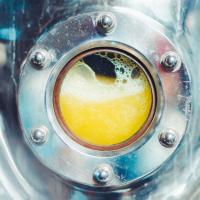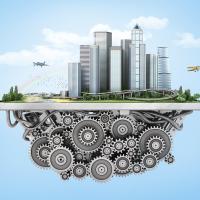As far as habits go, your daily morning coffee probably seems like an innocuous one. But the amount of coffee we, as a global society, consume actually threatens the existence of our planet.
“The coffee industry has known about the problems of coffee for over a decade.”
Andy Kleitsch
“The global demand for coffee is encouraging farmers to deforest land. And with the growth of coffee, production will have to triple over the next 30 years. And that means that all of the last wild forests will have to be destroyed. That’s what we’re trying to avoid.”
Atomo is spearheading a movement for sustainable coffee — coffee that’s produced without inflicting any further harm to the environment.
In fact, Atomo’s sustainable coffee doesn’t involve crop cultivation at all. Atomo is pioneering molecular coffee, a process for synthetically producing coffee molecules. Instead of the laborious, fuel-intensive, environmentally harmful process of growing and harvesting coffee beans and shipping them across the world, the coffee is produced in a lab filled with beakers and people in white coats.
“We get asked, ‘Is Atomo coffee?’” Kleitsch says. “The answer is yes. You can call Atomo coffee.”
The global warming threat
One of the biggest threats to the global coffee supply is global warming. The geographies where most of the world’s coffee is grown — Central America, Central Africa, India and Southeast Asia — are also the geographies most susceptible to the risks of global warming.
As temperatures increase in these locations, the quality of the coffee beans suffers. Higher temperatures cause coffee beans to ripen too quickly. “And that means it doesn’t have all the flavors that you would expect from coffee.”
This has caused coffee farmers to move their coffee farms to higher elevations that have previously been untouched by agriculture. Of course, to farm these areas, they need to clear out the trees, so the migration results in mass deforestation, further mitigating the effects of global warming.
It’s a vicious cycle, and one that shows no signs of slowing down. “The demand for coffee is simply too high. Cultivation is going to move to places where I wasn’t grown before. THere’s now talks of growing coffee in Florida.”
The solution, then, is to create a coffee process that is wholly sustainable.
Atomo’s quest to create sustainable coffee started with deconstructing just exactly what goes into a cup of joe. In doing so, they identified 28 different molecular compounds that make coffee taste like coffee.
“First we started just combining these purified compounds, putting them in a cup and tasting it,” Kleitsch says. “We look back at that first batch and say, ‘That was pretty bad coffee.’ But we could tell it was possible.”
To make the process sustainable, Atomo bought discarded crops — crops that would otherwise be considered waste — from local farmers. Many of these plants have the precursor compounds for coffee. “We actually focused on up-cycled ingredients,” Kleitsch says.
And to improve the consumption experience, Atomo focused on the five most important attributes of coffee: body, flavor, aroma, color and bioactives.
Atomo now has a cold brew coffee product available for public consumption. It comes in a recyclable can and it tastes like coffee.
Selling consumers on sustainable coffee
Atomo has the science behind sustainable coffee down. The biggest challenge, then, might be selling consumers on the idea.
People are obsessive about their coffee, and it might be hard for them to give up their organic, single origin Ethiopian beans for something produced in a sterile lab.
“Coffee is not just from a bush. It’s about the experience you have in the morning. Coffee is actually a ritual. That’s what we replicate.”
Kleitsch is not overly concerned about selling consumers on sustainable coffee. Consumers are increasingly cognizant of how their consumption choices affect the planet, and Atomo can capitalize on this trend by offering consumers a sustainable coffee option.
And perhaps more importantly, sustainable coffee is no different than traditionally sourced coffee at the point of consumption. Sustainable coffee is just as delicious, silky and comforting, despite not coming from a coffee plant.
In a blind taste test with Freethink, Atomo’s cold brew tasted and smelled just like a regular cup — and came in first in terms of overall drinking experience.
Atomo is exploring ways to make different varietals of coffee. Traditional coffee comes in many forms, flavors and preparations, and Atomo wants sustainable coffee to be similarly diverse.
“When we set out to create the perfect cup of coffee, it immediately started an argument about what is the perfect cup of coffee,” Kleitsch says of Atomo’s brainstorming sessions. “Some people like it dark and black and roasty. Some people like it light and milky with cream and sugar.”
That inspired Atomo to produce a batch of molecular coffee without the compounds that make traditional coffee taste bitter. It was a huge success. “It had all the roasty, toasty notes, but it didn’t punch you in the face,” Kleitsch says. “We removed all the negative defects of coffee and made an ultra-smooth, perfect cup of coffee.”
Now Atomo is trying to move beyond selling pre-packaged coffee drinks to selling sustainable coffee grounds. To create them, it has injected its coffee compounds into the pits of palm dates, which resemble coffee beans in size and shape. “For us, the bean is this magical vessel that releases its freshness when you grind it,” he says.
Atomo’s obsession with creating great tasting, fully sustainable coffee is a labor of love, Kleitsch says.
Andy Kleitsch
“We love coffee. We want coffee to be around for a long, long time.”
And coffee can’t continue unless a more sustainable process is developed.
“Coffee is such a huge industry, it’s hard to even get your hands around how large it is,” Kleitsch says. “If I think about my own coffee consumption, it’s about two coffee bushes a month.”


